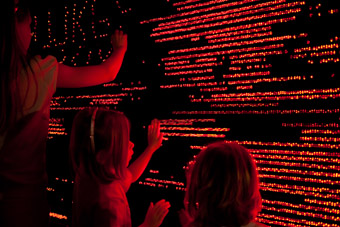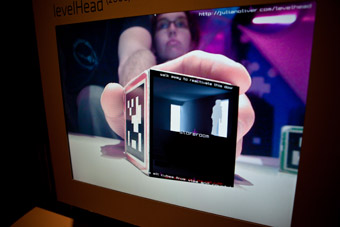exhibiting the future
alexandra crosby, ars electronica center, austria

L–E–D–LED–L–ED, dilight inc. (Japan), 2007, Ars Electronica Centre
photo Alex Davies
L–E–D–LED–L–ED, dilight inc. (Japan), 2007, Ars Electronica Centre
IT IS HARD NOT TO FEEL DAUNTED BY YOUR FIRST SIGHTING OF LINZ’S SPARKLING NEW ARS ELECTRONICA CENTER. IF YOU SEE IT FIRST AT NIGHT (IT’S IMPOSSIBLE TO MISS), THE COLOURED LIGHTS OF ITS FLASHING FACADE SHOUT ITS SIGNIFICANCE ACROSS THE DANUBE TO THIS SMALL AUSTRIAN CITY AND ITS DETERMINATION TO EXHIBIT THE FUTURE. ONCE INSIDE, HOWEVER, THE MUSEUM IS ENTIRELY MANAGEABLE. THE QUIRKY TURNSTILES AT THE ENTRANCE SET A LIGHT-HEARTED TONE, DEFLATING TO LET YOU PASS AFTER SCANNING YOUR TICKET.
The basement is arranged into a set of public ‘labs’ staffed by enthusiastic young assistants in orange uniforms who are eager to explain and demonstrate the exhibits, while simultaneously preventing any robot injuries or deaths. The Robolab is a lively buzz of human and machine voices, by far the most popular part of the museum and home to a very decent population of working prototypes, including Hexpod who plays soccer, Plenpark who dances, and Merz who sulks when you don’t pay her enough attention. Some may complain that this is a surface representation of robot genealogy, but a comprehensive survey of such a field would be difficult in any single space.
The highlights are The Haptic Radar which, when worn, allows you to navigate the space of the museum by responding to a series of rather unpleasant pulses to the perimeter of your head, and Philip Beesley’s elegant Hylozoic Soil, a huge mechatronic organism whose tentacles react as you approach them.
The Biolab tries hard to set a scientific atmosphere: white lab coats hang on the wall, and Petri dishes and test tubes fill the shelves. But all that is here is a disappointing set of light and electron microscopes, an exhibition of cloned tobacco plants and a DNA scanning station, all of which might be interesting if they were available for use, but seem like part of a technology trade show than anything to do with electronic arts.
The Fablab is another technology showcase, housing a remarkable 3D printer and Airdrawn, a three-dimensional design interface. However, with the help of assistants, you are invited to experiment with them. This is where it all gets very Questacon, and of course, kids love it.

LevelHead, Julian Oliver, Ars Electronica
photo Alex Davies
LevelHead, Julian Oliver, Ars Electronica
The Funky Pixels area, also in the basement, needs some devoted time. Offering a tranquil antidote to the science labs, the “shoes optional” lounge area has modular cushions, street art décor, and mood lighting. You can just sit around, playing with a range of experiments in interactivity. Although it is not perfectly installed, Julian Oliver’s Levelhead is as well-loved as ever, judging by how worn the cubes of the interface are. If you are patient enough, you can navigate through the elegant levels of his Escher-like labyrinth.
From the basement, I make my way up to the Deep Space theatre, which has a show on rotation every hour or so. This exhibit presumably replaces The Cave in the old AEC, famous as a pioneering VR environment for commissioned projects. Entering the theatre, we are handed 3D glasses and deep house music plays as we find positions. But the shows are uninspiring. Papyrate’s Island, an interactive 3D game could be great to experience if you could control and navigate the space. As a demonstration, however, it is more disorienting than fascinating.
The presentation of Leonardo da Vinci’s The Last Supper preserved as 16,118,035,591 pixels seems to be merely a way of using eight high definition projectors. Is this better than seeing the painting itself? Such unprecedented level of detail may be technically impressive, but adds no magic to da Vinci’s vision, even with the operatic soundtrack. There are other films on, but most of them leave you feeling you’re in an inferior Imax theatre with no seats (or popcorn). One can only hope that Deep Space will be used more creatively in the future.
One floor up is a retrospective of the work of Berlin design lab ART+COM. Installed on shipping crates and wooden palettes, the focus here is interdisciplinary experimentation: structural models, prototypes and documentation of new media research projects. The refreshing aspect of this floor is that, as a model for documenting projects, it acknowledges process and temporality and could have more works added at any time.
Poetry of Movement is by far the most impressive space in the center. It is packed with simple, elegant ideas that are well executed and don’t try to be anything other than good art. One corridor provides quality documentation of a number of winners of the prestigious Prix Ars Electronica, such as Dutch artist Theo Jansen’s lumbering, wind-powered, computer-designed skeletons, Strand Beasts. Another room is devoted to the marvellous robotic musical instrument Quartet by Jeff Lieberman and Dan Paluska, where 35 wine glasses make up the organ and 250,000 rubber balls fire at the marimba keys to perform a composition composed by a computer program from user input through a keyboard.
Arthur Ganson gets a whole room, which I was happy about even if it seems a little unbalanced. His Machine With Concrete is glorious, reminding us, in the midst of all the experimentation with cutting edge technology, that the world actually changes very, very slowly. The motor drives a series of gears and cogs, the last of which is fixed to a concrete block. The first rotation (in 1992) took about 14 seconds; the last one will take two trillion years.
This floor demonstrates that, in electronic arts, the kooky and low-fi can sit (if not comfortably, at least provocatively) next to the technologically seamless, and of the important aesthetic intersections of sound, kinetics and robotics.
Beyond being a museum, the Center is the permanent base for the Ars Electronica Festival. It is also home to Futurelab, a media art laboratory in which artists and scientists collaborate on the future, engineering exhibitions, designing installations and pursuing joint research ventures with universities and the private sector. This year’s festival (September 3-8) and the ongoing activities of Futurelab will be a test of the curatorial resilience of the new structure.
The Ars Electronica Center is indeed a landmark for the electronic arts, and for Linz itself, fortunately one that will live beyond the branding of the city as the 2009 European Capital of Culture. Like its predecessor, this museum is unique in the world as a showcase of the novel intersections of art and science. Some cynical Linz residents, however, call the center the “media arts brothel”—its curtain of lights are apparently very similar in hue and form, if not in scale, to a well-known red-light strip. With the hype of its opening in January and its slick presentation, the Ars Electronica Center begs the question, can the future be anything but overstated?
Ars Electronica Center, Linz, Austria, www.aec.at/center
RealTime issue #91 June-July 2009 pg. 31






